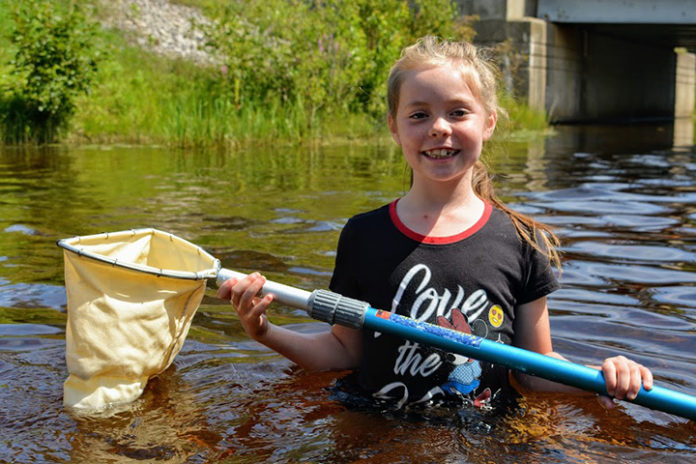Courtesy Photo
Jaeden Burke wades in the Ocqueoc River with a net for collecting macroinvertebrates in this photo provided by Huron Shores.
There’s a lot you can learn about our local streams if you’re willing to get a little wet and flip a few rocks.
While it’s trout that get all the attention on northern Michigan’s river systems — we do call them trout streams, after all — there would be no trout to speak of without macroinvertebrates.
By definition, macroinvertebrates include any river creature that lacks a backbone and can be seen without the aid of a microscope or magnifying glass. That includes the larval or nymph stages of flying insects, and we can use their presence and diversity to gauge a stream’s health.
Three taxonomic groups of nymphs are considered “indicator species” for healthy water. Scientists who study rivers have turned those three groups — ephemeroptera, plecoptera, and trichoptera, abbreviated as EPT — into a tool known as the EPT Index.
“These are our mayflies, stoneflies and caddisflies, and they are the most intolerant of poor water quality,” said Dylan Loop, coastal restoration technician for Huron Pines in Alpena, who has done that kind of research in his past work with the Great Lakes Coastal Wetland Monitoring Program. “Collecting and counting their nymphs is faster and easier than testing water samples in a laboratory.”
Mayflies, stoneflies, and caddisflies may spend years hiding in the streambed, clinging to logs or rocks or burrowed in silt. They eat algae, bits of plant matter, and other detritus, contributing in their own way to stream health by breaking down organic matter into smaller bits that can be used by creatures lower on the food chain.
They are also highly sensitive to changes in water quality and will die if a river gets too warm, low in oxygen, or polluted by surface runoff. Of all a river’s creatures, they are among the first to go. They are the so-called “canary in the coal mine,” and their absence means something is wrong.
It should also be noted that they are very good at hiding.
Simply put, more bugs means a healthier stream. It’s a fact long understood by fly anglers, who “match the hatch” at specific times of the year by casting flies resembling the larval or adult versions of whichever species is hatching on a given day.
Trout, a river’s top predator, key in on those hatches to feed, and anglers follow close behind.
Nick Theisen is one of those anglers. He was introduced to macroinvertebrates as a student in the Entomology Lab at Michigan State University and started fly fishing and tying flies soon after. As part of his service with Huron Pines AmeriCorps, he familiarizes others with macroinvertebrates by training volunteer stream monitors or teaching youth how nymphs relate to stream health.
Theisen and Huron Pines Water Program Director Samantha Nellis led two such workshops in August with the Alpena Boys and Girls Club on the Thunder Bay River, and Presque Isle County 4-H on the Ocqueoc River. They used dip nets to collect nymphs from the stream and utilized a flowchart to identify each one by its physical characteristics. Those events were supported in part by the Consumers Energy Foundation.
“Macroinvertebrates are a really fun introduction to stream science,” Theisen said. “They’re so easily overlooked, but, if you look close enough while flipping rocks or overturning logs, you’ll find more life than you’d ever expect.”
If you’re interested in collecting macroinvertebrates, you’ll need a sturdy butterfly net, a shallow container, and a hand lens to see details for identification. Be sure to place rocks, logs, and nymphs back in their original location in order to preserve their habitat and population. Identifying information and illustrations can be found at macroinvertebrates.org.
Chris Engle is communications associate for Huron Pines, a 501(c)(3) nonprofit organization based in Gaylord and Alpena to conserve and enhance Northern Michigan’s natural resources to ensure healthy water, protected places and vibrant communities. Huron Pines strives to improve economic, environmental, educational and recreational opportunities throughout Northern Michigan. Learn more at huronpines.org.
Credit: Source link































